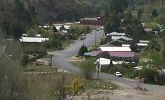| Captain's Flat mining
ventures now depended on the government's decision
whether to build a railway line from Bungendore. This
had been approved in principal, as early as 1930 without
further action, but in late 1937 the bill was finally
ratified. On 10 January 1939, the first ore rattled its
way out of Captain's Flat by rail.
The outbreak of war threatened the sales of lead and
zinc, with German, French and Belgian markets being
closed. Britain took the zinc for the production of
brass while the lead went to the United States for
smelting. The government gave considerable concessions
in power and freight charges to the mining company, to
ensure the continuation of overseas funds into
Australia.
By 1940 Lake George Mines employed 550 people and the
population increased in three years to 1,700. The
Yarrowlumla Shire Council, apart from making 2 seats
available on the council for Captain's Flat
representatives, did not spend much money on improving
the town. Therefore, the mining company built 190 fibro
cottages for married miners and a large hostel-type
building for single men, while others lived in tents
until more permanent accommodation was built.
A new theatre, hospital, swimming pool, ambulance
service, doctors, nurses, even football players were all
paid for by the company, as were street lighting,
electricity and domestic water. It is said that men came
to work in the mines just to get an opportunity to play
on the local football team! Meanwhile, the job of
sanitation, street and road improvements and upgrading
and garbage disposal fell to the Shire Council.
By 1956, they had sealed the major streets, built a
playground, swimming pool and tennis courts and
constructed kerbing and gutters. In 1955, local
residents had loudly criticised the Council for the lack
of money being attributed to the town and for the poor
state of disrepair of local roads.
Old buildings, relics of the old days suddenly became
obsolete. The hotel was demolished in 1939, after
construction began on a new, two-storey hotel was begun
in 1938. This building was fitted with a bar which
stretched 32 metres in length, which was the longest bar
in Australia at the time. Patrons guzzled down some 102
thirty six gallon kegs of beer every week, had 20 rooms
for accommodation, two dining rooms, a saloon bar and
large fireplaces for warmth.
Other businesses soon sprang up, with a garage and
service centre, five taxi companies and a bus service
catering for transport needs. Domestic services such as
a supermarket, dry-cleaner, chemist, butcher shops,
bakers, greengrocers, a dress shop, milk bars and cafes
all began trading.
The first bank in Captain's Flat was the Government
Savings Bank of NSW opened in 1889. This was later
changed to the Commonwealth Savings Bank which continues
to trade from the Post Office to this day. The Union
Bank opened its doors in a new building on the corner of
Foxlow and Kurrajong Streets in 1937. In 1951, this bank
was merged with the Bank of Australasia and became the
ANZ bank. Captain's Flat was a boisterous, prosperous
town built solely on the back of the mines.
But the relationship between the company and the
miners was not always a happy one. In 1948, one strike
lasted seven months, resulting in huge losses in pay and
production. It began in October when 430 miners asked
the company for an increase in their lead bonuses.
Instead, Lake George Mines offered them 20 percent share
in company profits. The miners refused and so began "The
Big Strike".
Both sides showed little animosity toward the other,
but neither would they back down. Miners who fell behind
in their rents were guaranteed that they would not be
evicted from their company houses. Money became
extremely scarce and strike funds were issued to miners
at the rates of £2 to single men, £2/5/- to married men
and 2/6 per child dependant.
Then again in 1954, another protracted strike began.
The mining company had been going through a time of
hardship, during which the miners agreed to forego their
lead bonus to help out. The company then asked the
miners to work longer hours and this triggered a
walkout. The miners also banned the company from
bringing in outside contractors to sink the main shaft
deeper.
Lake George Mines ceased operations and sacked some
300 men. The Australian Workers Union agreed with mine
management to allow outside contractors access to work
on the main shaft, but the miners on strike refused to
comply with the agreement until all men sacked were
reinstated. Other unions supported the striking miners
with strike funds paid as food stamps.
This strike cost the company £750,000 in unmined ore
and the workers £350,000 in lost wages. Miners began
turning back their electricity meters to save money,
some being so adept at this that the company actually
paid them refunds. Though the strike cost both sides
dearly, conditions at the mines became among the best in
the country. Management told the miners that if this
kind of actions were continued, the mines would
eventually close. But it was simply a lack of viable ore
to be mined that finally forced the mines' closure in
1962. |
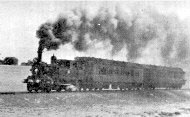
A steam train on the track to Captain's Flat
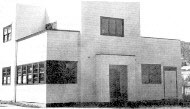
The Union Bank, later became the ANZ Bank. The building
was used as a supermarket before being destroyed by fire
in 1981.

Captain's Flat taxi and busline fleet in 1952
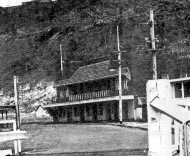
The Captain's Flat Hotel built in 1938. It boasts a 32
metre long bar
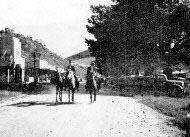
Riding into town on a Saturday evening. Car parking was
scarce
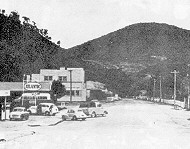
Looking south down Foxlow Street in the 1950's. The
petrol station is in the foreground with the Union Bank
building behind
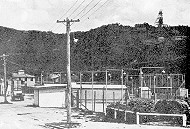
Looking south down Foxlow Street in the 1950's showing
the floodlit tennis and basketball courts. Note the mine
poppet on the hill behind |
